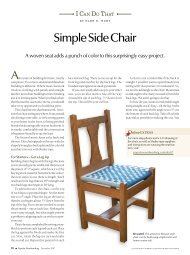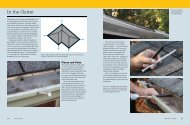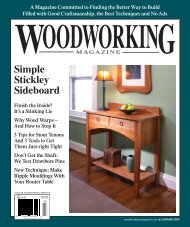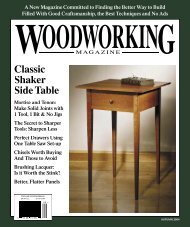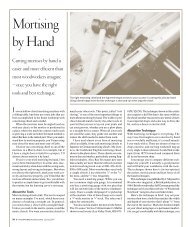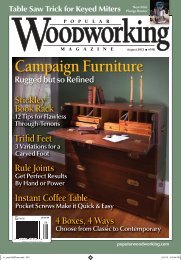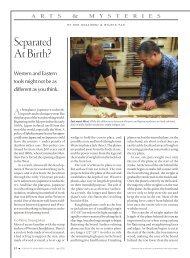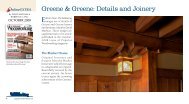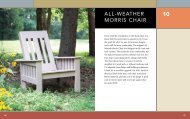STAGE 3: Honing the Secondary BevelTo hone the secondary bevel, you want to sharpen only at the cutting edge – sharpening theentire bevel is a waste of time. So you need to shift your tool in the guide a bit so only theleading edge contacts the stone. I usually shift the tool back 1 ⁄ 4 " in the guide; this adds a 2°or 3° secondary bevel. This works with all makes and models of the side-clamping guide thatI’m aware of.STAGE 4: Polishing theSecondary BevelThe motions are the same for polishing asthey are for honing. Keep the tool in thesame position in the guide and place it onthe waterstone. Some polishing stonesrequire you to first build up a slurry with asecond little stone, called a Nagura. Adda little water and rub the Nagura on thepolishing stone until a thin film of slurryappears over the entire surface of thewaterstone. Now you are ready to polish.First loosen the screw on the guide and shiftthe tool backwards. I mark this second settingon my bench, which speeds my sharpening.Retighten the guide’s screw.Second, place the guide on your coarsewaterstone at the far end. Place even pressureon the chisel and pull the guide toward you ina smooth motion. Roll the guide forward usingalmost no pressure. Repeat this motion fivemore times and then examine your edge.Place the guide on the far end of the stoneand roll it toward you. Repeat this motionfive more times and examine your edge.Secondary bevelYour secondary bevel should appear as aseries of fine scratches in a narrow band at thecutting edge. Feel for the burr. If you can’tfeel it, repeat the six strokes on the coarsewaterstone. When you can feel the burr andthe scratches appear consistent on thesecondary bevel, move to the next step.BurrThe burr is almost impossible to photographbecause it is so small, but we got lucky here.The small wire lying across the bevel of the toolis indeed the burr, which detached from theface when I pushed my thumb against it. Nowyou know how small the burr is.The edge should look like a mirror all theway across. You should not be able to feel aburr on the face of the chisel, but it’s there.You must remove the burr before proceedingto polishing. Use your polishing waterstone.When removing the sizable burr left by thecoarse waterstone, you want to take carebecause the burr can score the stone. Pressthe face lightly against the polishing stone andpush forward. Repeat this a couple of timesand increase the pressure slightly. When theburr is gone, you can move to polishing.Remove the burr from the face of thechisel. Remove the chisel from the guide,place it face-down on the polishing stoneand push it forward once. Rubbing back andforth will scratch the face needlessly. WM14 ■ woodworking magazine Autumn 2004
Bevel-edge ChiselsFFor any one project, a set of chisels can be usedto pare, chop, scrape, clean up, clean out or (eventhough you shouldn’t) open cans. In short, it is amust-have in the toolbox. Owning a good first setis invaluable, but choosing that set can be hard.A chisel should be easy to set up, endure a fairamount of abuse before it needs to be rehonedand feel comfortable in your hand – even afteryou’ve chopped out a dozen dovetails. You alsoneed to pay attention to a chisel’s side bevels, asshown below. (Smaller is better for cleaning outtight joints.) So we put five common, reasonablypriced 1 ⁄ 2 " chisels through a series of tests to helpyou select a good first set.3 ⁄ 32" side bevelThe side bevel on the Craftsman (above) is too bigat the tip (it’s 3 ⁄ 32 ") to clean out dovetail joints. TheSorby’s 1 ⁄ 32 " side bevel is much better.ASHLEY ILESMARPLES BLUE CHIPOur Four TestsFirst we set up each tool, lapping the back until itwas flat, then honing the bevel to a razor-sharp,30° edge. (Typically you would use a 25° bevel ona 1 ⁄ 2 " chisel, but 30° is better for chopping.)Next, we tested edge retention. We drove eachchisel with a mallet 20 times into a piece of ash,then inspected each cutting edge under a rakinglight with a jeweler’s loupe. We then pared a pieceof cherry’s end grain with each chisel. We repeatedthis routine until the tool required rehoning,at which point it was removed from the test.To test the ergonomics of each tool, five editorsused the tools in different applications. The size ofour hands vary widely, so the results vary, too.Finally, we tested hardness on the Rockwell“C” scale using an industrial hardness tester atthe University of Cincinnati’s College of AppliedSciences. David Conrad, the director of the CertificateProgram, performed this test.SORBY CABINETMAKER’SCRAFTSMANSTANLEYConclusionsIn the end, we determined none of these tools isperfect. But three will get the job done comfortablywithout requiring hours of set-up time: TheAshley Iles is balanced, quick to set up and heldits edge reasonably well; the Marples is inexpensiveand performed adequately in every test; andthe Sorby held its edge very well and is a beautifultool. All earn our “Recommended” rating, butnone can be called “Highly Recommended.” TheAshley Iles’ and Marples’ edges could have heldup longer, and the Sorby, which some editors saidwas uncomfortable, took too long to set up.We can’t recommend the Craftsman and Stanleychisels. Their bevels are too big for cutting intothe tight corners of dovetails, they’re a chore to setup and they’re uncomfortable to use – especiallywhen your hands get sweaty. The word to describethese isn’t inexpensive – it’s cheap. WM– Kara GebhartBevel-edge ChiselsBRAND PRICE* HANDLE LENGTH SETUP EDGE ERGONOMICS BLADE CONTACTTIME RETENTION HARDNESS**RecommendedAshley Iles $83.25/ Bubinga 7 1 ⁄ 2 " Easiest Edge looked fantastic Short, smooth handle 59/32*** 800-426-4613 orset of 4 throughout; paring ideal for chopping and toolsforworkingwood.comincreasingly difficult; comfortable for paring3rd most durableMarples $42.50/ Plastic 10 1 ⁄ 4 " Adequate Paring increasingly more Handle orients easily in 60 1 ⁄ 2 /60 1 ⁄ 2 800-871-8158 orBlue Chip set of 5 difficult after a few rounds; hand; some editors leevalley.com4th most durablesuggest cutting plasticseam off for best results3⁄8Sorby $144.90/ Boxwood 10 3 ⁄ 8 " Longer than Edge looked awful with Results mixed; some 59/59 800-225-1153 orCabinetmaker’s set of 4 acceptable deep nicks and crumbling editors suggest woodcraft.comacross; pared very well; breaking octagonal2nd most durable edges for best resultsNot RecommendedCraftsman $19.99/ Plastic 9 1 ⁄ 4 " Unacceptable Most durable Results mixed; plastic 60/60 800-377-7414 orset of 3 slippery when hands craftsman.comget sweaty3⁄4Stanley $14.46/ Plastic 7 3 ⁄ 4 " Unacceptable Edge immediately showed Similar to Ashley Iles; 58/58 1 ⁄ 2 Available at mostset of 3 big nick and crumbling; plastic slippery when home-supply storesleast durablehands get sweaty*Prices as of publication deadline. **From Rockwell “C” scale. First number is hardness of metal measured 3 ⁄ 4 " up from cutting edge. Second number is hardnessmeasured 1 1 ⁄ 2 " up from cutting edge. ***Great difference indicates steel near cutting edge has been hardened and steel near handle has been tempered.woodworking-magazine.com ■ 15



